Welcome, AI Visionaries!
In Rome, AI is filling in missing history. In Nairobi, it’s flagging clinical mistakes before they happen. Meanwhile, in Washington, it’s being handed the keys to federal policy with barely a seatbelt. Whether it's reconstructing the past or rerouting the future, the message is the same: these models are making the calls now.
📌 In today’s Generative AI Newsletter:
DeepMind’s Aeneas rewrites lost Latin with historical insight
Trump’s AI plan strips the brakes, hits the gas, and redefines neutrality
OpenAI in Nairobi shows real-world medical errors slashed with AI
YouTube’s photo-to-video tools make everyone a creator
🪨 When in Rome, Ask the AI: DeepMind’s Model Reconstructs Ancient History

Image Source: Google Deepmind
A new AI model from Google DeepMind is helping historians tackle one of antiquity’s toughest puzzles: incomplete Latin inscriptions. Trained on nearly 200,000 ancient texts, Aeneas identifies lost words, narrows down dates, and pinpoints origins not just by comparing words, but by tracing deep contextual connections across time, geography, and syntax.
Here’s what it can do:
Restores missing words in fragmented inscriptions using pattern recognition and historical context
Predicts provenance and date with up to 72% location accuracy and 13-year time resolution
Finds historical parallels using a fingerprinting method that links texts across centuries
Supports multimodal input, analyzing both text and images for richer interpretation
In testing, Aeneas dated Augustus’ Res Gestae to two key periods that match ongoing scholarly debate. In another case, it linked a German votive altar to a local precedent by spotting subtle stylistic echoes, the kind of insight that once took years of expertise. Cambridge classicist Mary Beard called it “transformative,” while other scholars noted it could democratize research, expanding who gets to interpret the past.
🗳️ Trump’s AI Doctrine: Innovation First, Guardrails Later

Source: AMERICA'S AI ACTION PLAN 2025
The Trump administration’s long-awaited AI Action Plan trades caution for acceleration. The new doctrine leans into speed, scale, and infrastructure while stripping references to climate change, diversity, and misinformation while championing “ideological neutrality” as a federal standard.
Key elements of the plan include:
Eliminating references to misinformation and bias, instead emphasizing “ideological neutrality” as a guiding principle for federal AI policy.
Accelerating data center development through fast-tracked permitting, energy prioritization during grid stress, and use of federal lands to expand compute capacity.
Rejecting climate and DEI-related provisions, with language dismissing them as impediments to innovation and economic growth.
Expanding workforce programs focused on AI infrastructure, including local partnerships to create jobs tied to data center operations.
Architected by tech-aligned policy leaders, including Michael Kratsios and David Sacks, with input from over 10,000 public comments.
The plan frames AI as a patriotic imperative and casts government oversight as a threat to progress. It’s not yet clear how many of these proposals will be enacted, but one thing is certain: America’s AI future just took a hard ideological turn. What’s left unsaid is just as notable as what’s included.
🩺 OpenAI’s AI Copilot Slashes Medical Errors in Nairobi Clinics

Image Source: @thekaransinghal on X
OpenAI and Penda Health just wrapped a major study in Kenya showing how AI copilots can cut real-world mistakes in busy medical clinics. Across nearly 40,000 patient visits, clinicians using the GPT-4o-powered system made 16% fewer diagnostic errors and 13% fewer treatment mistakes than those working without it.
Here’s what made it work:
Real-time feedback: The AI flagged risks as clinicians worked, offering guidance without taking control
Human-first approach: Doctors remained fully in charge, treating the AI like a second opinion, not a boss
Solid tech + good fit: GPT-4o was accurate, and the tool blended into existing workflows without slowing care
Clinician buy-in: Every doctor surveyed said care quality improved, with 75% calling the AI “substantially” helpful
The success of this pilot rests on simple ingredients: accurate models, thoughtful training, and smart design that respects how doctors already work. Many AI tools struggle to cross the chasm from demo to deployment. This one walked into a real clinic and helped save lives.
🎬 YouTube Shorts Rolls Out Image-to-Video AI Tools

Image Credits: YouTube
Google is expanding its AI-powered photo-to-video features to Google Photos and YouTube Shorts, letting users animate their memories in bite-sized clips. The rollout uses the older Veo 2 model and limits user control, but still brings creative tools to more users across Android and iOS. The features prioritize speed and simplicity, offering fixed options instead of free-form prompts.
Here’s what’s in the director’s cut:
Photos can now become 6-second clips, powered by Veo 2 and a menu of preset vibes like “Subtle movements” and “I’m feeling lucky”
YouTube Shorts adds AI effects for doodle-to-image and selfie transformations (yes, including underwater you)
No custom prompts allowed, just curated templates, call it “generative AI for the indecisive”
All outputs are watermarked, including SynthID invisibly and a visible badge on Photos videos
There’s also a Remix tool coming soon to photos, turning images into anime, sketches, and 3D styles, all housed under a new “Create” tab. It’s a glimpse at AI creativity made safe for the masses: sandboxed, stylized, and spoon-fed. The future might be cinematic, but for now, it’s capped at six seconds.

🚀 Boost your business with us. Advertise where 12M+ AI leaders engage
🌟 Sign up for the first AI Hub in the world.



